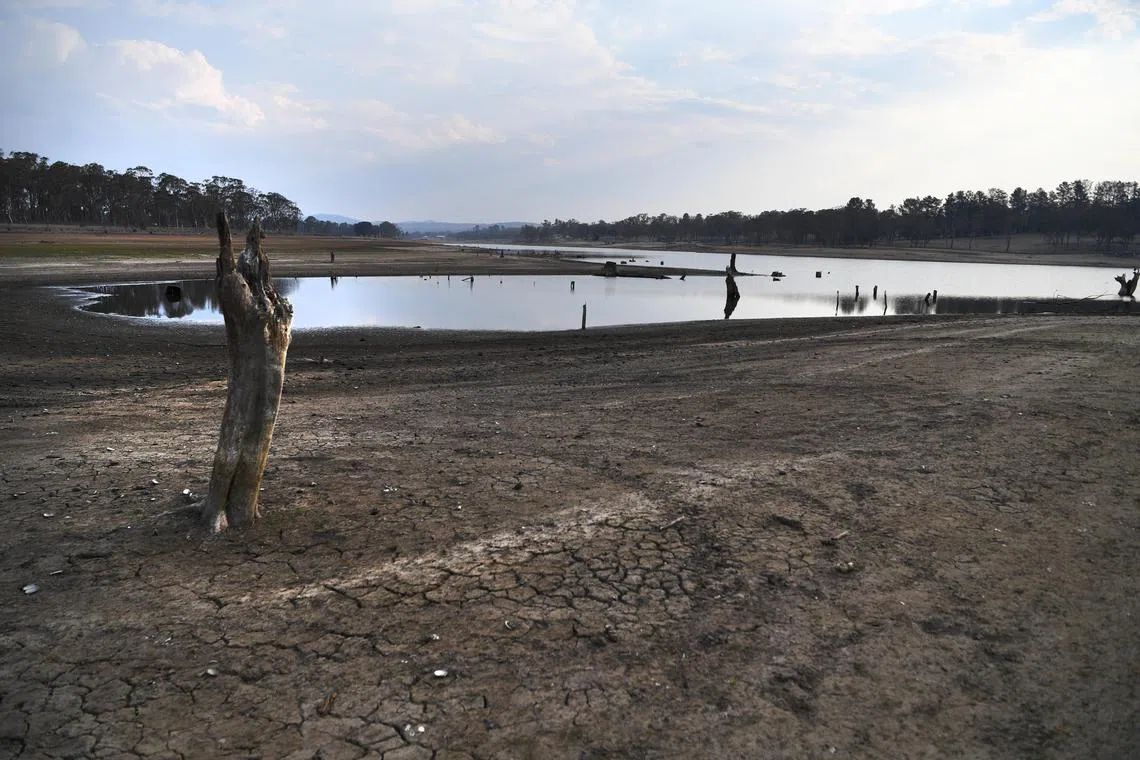Australia braces itself for drought and fires in El Nino’s wake
Sign up now: Get insights on Asia's fast-moving developments

Experts believe that the bushfire risk is mounting this year because Australia has just experienced three years of La Nina events.
PHOTO: AFP
Follow topic:
SYDNEY - Amid the brutally cold winter weather in Sydney in recent days, the distinctive smell of bushfire smoke hangs, disconcertingly, in the air.
The smoke has blown in from a series of large fires in bushland surrounding the city – controlled burns conducted by the New South Wales (NSW) Rural Fire Service, the state’s main bushfire fighting agency.
The burns are a crucial part of efforts by the authorities in Australia to prepare for the looming bushfire season, which occurs in the warmer months at the end of the year.
But there is an extra urgency this season.
Australia, a dry continent that is prone to bushfires and drought, is bracing itself for El Nino, a weather event that tends to cause warmer, drier conditions
El Nino is a periodic warming of sea surface temperatures in the eastern tropical Pacific Ocean that affects weather patterns in South-east Asia and Australia, usually leading to less rain. La Nina, the flip side to El Nino, brings warmer waters to the Western Pacific and cooler and wetter weather to the region.
According to the national government’s Bureau of Meteorology – which says there is a 70 per cent chance of an event in 2023 – Australia’s severe droughts in recent decades have all been associated with El Nino conditions. The drier weather also brings a much higher risk of a significant fire season in south-east Australia.
This is worrying news for Australia, where bushfires have become far more severe in recent years.
During the so-called Black Summer fires of 2019 to 2020,
The fires damaged thousands of homes and razed more than 24 million ha of farm and bushland, covering an area about the size of the United Kingdom.
Experts believe that the bushfire risk is mounting in 2023 because Australia has just experienced three years of La Nina events, which brought cooler, wetter weather that helped forests to regrow following the Black Summer fires.
“We know from the historical record that bushfire events are more likely during periods of El Nino, whereas floods and cyclones are less likely,” Dr Tom Mortlock, an analyst at risk advisory firm Aon, told The Australian Science Media Centre.
“The concern now is that – with the long absence of El Nino and back-to-back La Ninas – the landscape is preconditioned for bushfire, with significant fuel growth occurring.”
Mr Greg Mullins, a former commissioner of Fire and Rescue NSW and one of Australia’s most experienced firefighters, told The Straits Times that the nature of Australia’s bushfires has dramatically changed during the 50 years that he has been fighting fires.
The bushfires have become “different” and “terrifying” and “uncontrollable”, a worrying phenomenon that he says is due to climate change.
And so, when events such as El Nino occur now, Australia faces a heightened risk of catastrophic fires.
“History says that we immediately get fires after a triple La Nina, and if you add in an El Nino, it’s an ‘oh no’ moment,” he said. “You shake your head and say here we go again.”
A triple La Nina, or “triple-dip” La Nina, refers to the event lasting three consecutive years, which is rare.
There are serious doubts over whether Australia is ready to combat another summer of devastating fires. Following the Black Summer bushfires, a Royal Commission made a range of recommendations for improving safety, including measures to enhance coordination between the federal government and the states, which are responsible for front-line firefighting.
New laws were introduced to allow the federal government to declare a national state of emergency and have greater scope to assist states during disasters, while the role of the military in disaster recovery has been expanded.

Firefighters tackle a bushfire in thick smoke in the town of Moruya, south of Batemans Bay, in New South Wales, on Jan 4, 2020.
PHOTO: AFP
A group of former senior Australian fire and emergency service leaders has warned that the federal government has failed to adopt the main recommendations from the Royal Commission.
Emergency Leaders for Climate Action – a coalition of former senior Australian fire and emergency service leaders formed by Mr Mullins – says the government has not acquired adequate aerial firefighting capabilities, developed real-time air quality information, nor done enough to inform the public about the risk of disaster and the need to properly prepare.
Mr Mullins said more needs to be done to ensure that state firefighting agencies cooperate, especially as fires in the climate change era “all burn at the same time in different states, rather than sequentially”.
He said the federal government should also provide grants for residents in bushfire-prone areas to adopt safety measures such as closing gaps in roofs and putting grills on windows that keep sparks out.
“Black Summer will happen again in Australia,” he warned.
Beyond the risk of drought and bushfires, an El Nino event in 2023 could also have grave consequences for the Great Barrier Reef, which is coming under increasing threat from warmer water temperatures caused by climate change. The reef’s corals have experienced six mass bleaching events since 1998,
Coral reef expert Charlie Veron said last week that the reef’s most serious bleaching events have occurred during El Nino years, which can lead to cloudless skies that – along with warmer water temperatures – also cause bleaching.
“The question is how much of the Great Barrier Reef is going to be affected – if those clear blue skies occur over the entire reef, it could all be bleached,” he told news.com.au.

A nearly dry reservoir of the Storm King Dam near Stanthorpe, Queensland, Australia, on Oct 10, 2019.
PHOTO: EPA-EFE
As the nation awaits confirmation of whether El Nino is under way, farmers say they have already seen their land begin to dry.
Mr Scott McCalman, a farmer in north-west NSW, told NBN News earlier in June that his crops were “struggling” and that he was preparing for lower yields as the nation braced itself for El Nino.
“We really haven’t had our average rainfall,” he said. “It’s been very challenging.”


